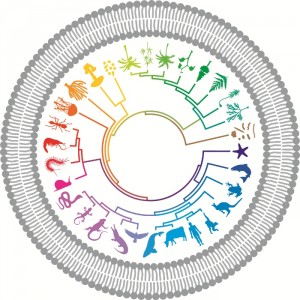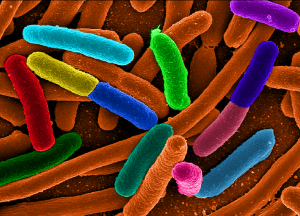 In the bacterial RNA polymerase transcription complex, the sigma factors play the role of guide, specifying where in the genome the complex binds – and thereby which genes are turned on at any one time.
In the bacterial RNA polymerase transcription complex, the sigma factors play the role of guide, specifying where in the genome the complex binds – and thereby which genes are turned on at any one time.
Lab favourite E. coli has seven such sigma factors, one of which has a ‘housekeeping’ role in standard conditions, with the other six swapping into the complex under particular individual stresses – perhaps the most important (at least from a human perspective) role of these alternative sigma factors being the regulation of virulence genes.
A new study from Bernhard Palsson and colleagues in BMC Biology gives a genome-wide view of transcriptional regulation by these factors, through a combination of transcriptome analysis, sequencing of transcriptional start sites, and chromatin immunoprecipitation of the different sigma factors.
What emerges looks nothing like a traditional textbook model where each protein has a separate, neatly-defined function. Instead, there is a complex network of connections, with various sigma factors regulating both each other and themselves, and extensive overlap between their sets of target promoters; sigma factors both compete with each other for binding, and cover for each other when missing.

This won’t be a complete surprise to those who’ve been following the biology of bacterial transcription: similar individual results have been noted before in small-scale experiments. However, this study recapitulates essentially a few decades’ work in a single set of high-throughput experiments, representing a powerful tool for studying transcriptional networks.
The authors raise the possibility of “developing a comprehensive reconstruction of the entire transcriptional regulatory network in E. coli”, and this is a tempting idea: being able to predict the network-wide effects of perturbing a particular gene can offer insights into how these changes might affect the organism as a whole. Genes with many network connections can be the “capacitors” of evolutionary change discussed by Joanna Masel in a recent Q&A for BMC Biology and touched on by Marc Kirschner in his discussion of evolvability, and the sigma factors have many connections indeed.
Kester Jarvis
Latest posts by Kester Jarvis (see all)
- The agony of choice: conservation biology and choosing what to save - 18th March 2014
- Sigma factor networking and bacterial versatility - 30th January 2014
- Electricity generation and fish populations: how a power station provided a rich biological dataset - 4th September 2013
Comments